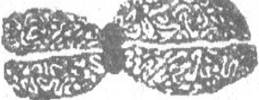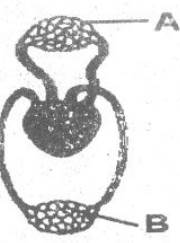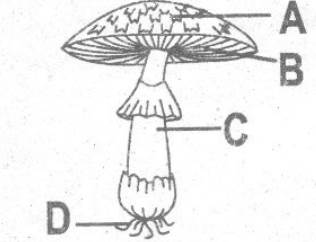Federal Board HSSC-I (2012)
BIOLOGY
Time: 25 Minutes
Marks: 17
Note: Section-A is compulsory and comprises pages 1-2. All parts of this section are to be answered on the question paper itself. it should be completed in the first 25 minutes and handed over to the Centre Superintendent. Deleting/overwriting is not allowed. Do not use lead pencil.
SECTION — A
Question#1
- What is the number of naturally occurring chemical elements?
A) 32
B) 92
C) 150
D) 102
- Which of the following can be defined as the group of living organisms of the same species located in the same place at the same time?
A) Species
B) Community
C) Population
D) Individuals
- The diagram below shows part of a Polysaccharide chain. What type of bond is X?
A) 
B) 
C) 
D) None of These
- The non-protein part is covalently bonded to protein part of enzyme is known as
A) Apo enzyme
B) Holoenzyme
C) Prosthetic group
D) Co-enzyme
- Which of the following cells secretes hydrochloric acid?
A) Mucous Cells
B) Zymogen Cells
C) Epithelial Cells
D) Oxyntic Cells
- In which phylum has the sexual phase NOT been observed?
A) Ascomycota
B) Deuteromycota
C) Basidiomycota
D) Zygomycota
- Extreme changes in pH cause the bonds in the enzyme to break, resulting in the enzyme
A) Denaturation
B) Saturation
C) Competition
D) Inhibition
- Shark liver oil is extracted and used in medicine as a source of vitamin.
A) B
B) A
C) D
D) A and D
- Which metal atom is present in chlorophyll?
A) Cu
B) Fe
C) Mg
D) K
- The role of Fungi in Mycorrhizae associations is to
A) Produce necessary nutrients
B) Increase the absorptive surface of plant roots
C) Provide a substitute of plant leaves
D) Increase the absorption of plant Shoots
- Which structure does the following diagram represent?

A) Chromosome
B) Chromatid
C) Centrosome
D) Centromere
- How many Capsomeres are present in the capsid of Herpes virus?
A) 152
B) 160
C) 162
D) 161
- Which of the following is NOT globular protein?
A) Myosin
B) Haemoglobin
C) Antibodies
D) Hormones
- Cell wall is secreted by the
A) Nucleoplasm
B) Protoplasm
C) Ceritriole
D) Glyoxisomes
- Which is NOT true for bryophytes?
A) Dwelling gametophyte plant
B) Presence of Xylem and Phloem
C) Sporophyte dependent in gametophyte
D) All of these
- The figure below shows four different types of viruses. Which one is Influenza virus?
A)

B) 
C) 
D) 
- There is a rasping tongue-like structure in molluscs called
A) Radula
B) Blastula
C) Gastrula
D) Morula
BIOLOGY HSSC-I
Time allowed: 2:35 Hours
Total Marks = 68
Note: Sections B and 'C comprise pages 1-2 and questions therein are to be answered on the separately provided answer book. Answer any fourteen parts from Section 'B' and attempt any two questions from Section'C. Use supplementary answer sheet i.e. Sheet-B if required. Write your answers neatly and legiblySECTION B
(Marks 42)
2. Attempt any FOURTEEN parts.The answer to each part should not exceed 3 to. 4 lines.
- Show how dipeptide is formed from two amino acids.
- a) What are amphibious plants?
b) Why are the Sphenopsids also called Arthrophytes?
- Why is there no special transport system in Planaria?
- All vertebrates have closed circulatory system:

a) Identify the given diagram.
b) State how you have identified it.
c) Name the parts labelled A and B in the above figure.
- Mitochondria manufacture and supply energy to the cell:
a) Write the chemical nature of Cristae.
b) Where are the organic and inorganic salts present?
c) From where do they extract energy?
- Write about the capsule of Adiantum.
- Write any three steps involved in the evolution of seed habit.
- a) Rubisco acts as two enzymes. Write down their names. How does it decide its way?
b) What is biological nature of Rubisco and where is it found?
- Write the molecular formulae of Chlorophyll 'a' and 'b'. How do they differ from each other?
- Why is the misuse of antibiotics dangerous?
- Closing and opening of stomatal pores affect the rate of transpiration:
a) How does K+ ions help in the closing of stomata?
b) Which hormone is released to stop the active transport of K* ions?
- Draw and label the diagram of the Discharged Nematocyst
- The cell wall is found both in bacteria andplant cell:
- How is the cell-wall of Archaeo-bacteria different from Eubacteria?
- a) How Is the age of fossils calculated?
b) Name the bird fossil which had bony teeth
- a) Differentiate between Radial and Bilateral Symmetry
b) What Is Syrinx? 01
- Identify the diagram given below and name the parts labelled A, B, C and D:

- a) What is Cyanosis?
b) Define Chlorosis.
- How are bacteria used in genetic engineering?
- Ancylostoma duodenale is parasite:
a) Why is it dangerous?
b) Name two diseases caused by it.
SECTION - C
(Marks 26)
Note: Attempt any TWO questions. All questions carry equal marks.
Question#3
a) What is Double Fertilization? Explain the life cycle of the plants in which double fertilization takes place.
b) What is the significance of alternation of generation?
Question#4
a) Discuss the salient features of Phylum Porifera
b) Differentiate between Protostomes and Deutrostomes.
Question#5
a) Synthesis of sugar takes place in light independent reaction:
b) What is Calvin cycle? Explain Reduction and Regeneration of CO2 acceptor Also draw the diagram.


